Goat Funded Futures Review
Goat Funded Futures is the futures trading branch of Goat Funded Traders. You can choose an evaluation or instant funding, trade 55 futures markets with no platform fees, and keep 100% of your first $10K in profit.
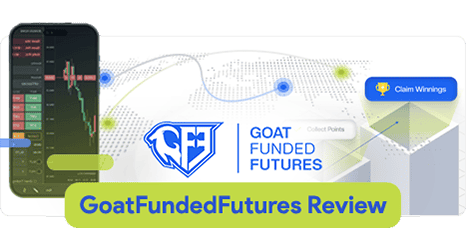
Goat Funded Futures is the futures trading branch of Goat Funded Traders. You can choose an evaluation or instant funding, trade 55 futures markets with no platform fees, and keep 100% of your first $10K in profit.
Written by Noam Korbl
Updated:

Our prop firm comparisons and reviews are reader supported and we may receive payment when you click on a link to a partner site. For more information, read our About Us page.
Goat Funded Futures Summary
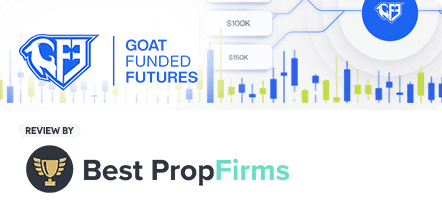
| 💳 Challenge Fees | $349 – $699 one off or $99 – $349 per month |
| 💰 Profit Split | 90% – 100% |
| 💵 Account Size | $25K – $150K |
| 📊 Trading Platforms | Project X, NinjaTrader, Quantower, and more |
| 🛍️ Markets Offered | Futures Markets |
Goat Funded Futures scores 65/100 overall during our internal testing and assessment. You get 100% of the first $10K in profit, and can choose between subscription-based or one-time fee models. All plans include access to 55 futures markets and advanced platforms like NinjaTrader, Quantower, and Project X, with no added costs for data or software.
The futures prop firm has clear payout rules and flexible account types, but weak customer support and high reset fees limit its appeal. There’s little educational guidance, and consistency rules can be strict, especially for Instant Funding accounts with no reset option.
The overall rating is based on review by our experts
Goat Funded Futures offers three evaluation types: EOD, Static, and Instant Funding. Each model has different pricing, rules, and drawdown logic. EOD and Static follow a monthly subscription structure, while Instant is a one-time fee model with immediate funding upon passing. There are no minimum trading days in subscription models, but the Instant option requires at least 10 days to qualify for your first profit payout.
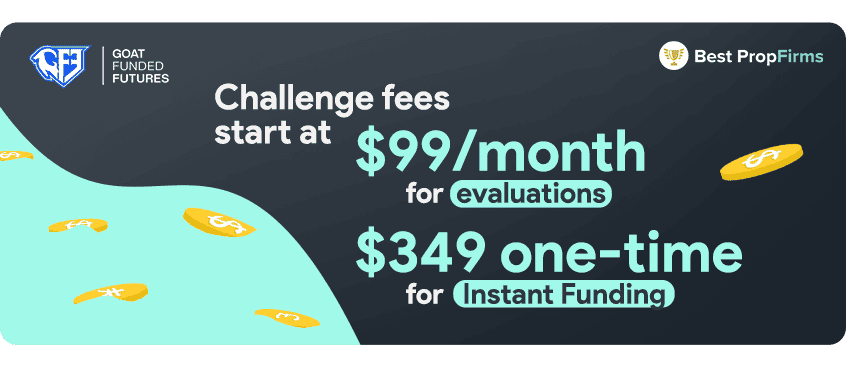
| Feature | EOD | Static | Instant Funding |
|---|---|---|---|
| Account Sizes | $50K, $100K, $150K | $30K, $75K | $25K, $50K, $75K |
| Fee Type | Monthly Subscription | Monthly Subscription | One-Time Fee |
| Cost Range | $99 – $249/month | $199 – $349/month | $349 – $699 |
| Profit Target | 8% – 9% | 5.33% – 8.33% | 7% (for first payout) |
| Max Drawdown | 3.67% – 5% (Trailing, EOD) | 3.33% – 4.17% (Static) | 5% (Trailing, real-time) |
| Daily Loss Limit | Funded stage only: 2.5% | None | 3% |
| Min Trading Days | None | None | 10 days before first payout |
| Reset Fee | $99 | $349 | Not Available |
| Consistency Rule | 50% (Eval), 30% (Funded) | 50% (Eval), 30% (Funded) | 20% of total profit per day |
| Drawdown Mode | Trailing (EOD applied) | Static | Trailing (real-time) |
| Scaling in Evaluation | Yes (based on profit milestones) | Not specified | Not applicable |
![]() The EOD (End of Day) evaluation is designed for traders who want lower drawdown pressure and time flexibility. There are no daily loss limits during evaluation, and you’re not restricted by a minimum number of trading days. Drawdown is calculated on an end-of-day basis, giving you more breathing room for intraday volatility. Once funded, a 2.5% daily loss limit applies.
The EOD (End of Day) evaluation is designed for traders who want lower drawdown pressure and time flexibility. There are no daily loss limits during evaluation, and you’re not restricted by a minimum number of trading days. Drawdown is calculated on an end-of-day basis, giving you more breathing room for intraday volatility. Once funded, a 2.5% daily loss limit applies.
The EOD model is the only one that allows you to scale contract size while still in the evaluation phase. This makes it ideal if you’re confident in your consistency and want more room to grow before funding.
| Account Size | Monthly Fee | Profit Target | Max Drawdown | Daily Loss Limit (Funded) | Max Contracts | Drawdown Mode | Reset Fee | Consistency Rule (Eval/Funded) |
|---|---|---|---|---|---|---|---|---|
| $50,000 | $99 | $4,500 | $2,500 | 2.5% | 5 minis / 50 micros | EOD | $99 | 50% / 30% |
| $100,000 | $149 | $9,000 | $4,000 | 2.5% | 9 minis / 90 micros | EOD | $99 | 50% / 30% |
| $150,000 | $249 | $12,000 | $5,500 | 2.5% | 12 minis / 120 micros | EOD | $99 | 50% / 30% |
![]() The Static model uses a fixed drawdown that never trails your equity. This means you can build up a buffer without your max drawdown shifting upward as your profits increase. There are no daily loss limits and no minimum trading days. This model suits traders who want predictable risk limits and more time to trade without pressure.
The Static model uses a fixed drawdown that never trails your equity. This means you can build up a buffer without your max drawdown shifting upward as your profits increase. There are no daily loss limits and no minimum trading days. This model suits traders who want predictable risk limits and more time to trade without pressure.
You can’t scale contract size during evaluation under Static rules, but once funded, the account follows GFF’s normal funded scaling structure.
| Account Size | Monthly Fee | Profit Target | Max Drawdown | Daily Loss Limit | Max Contracts | Drawdown Mode | Reset Fee | Consistency Rule (Eval/Funded) |
|---|---|---|---|---|---|---|---|---|
| $30,000 | $199 | $2,500 | $1,250 | None | 2 minis / 20 micros | Static | $349 | 50% / 30% |
| $75,000 | $349 | $4,000 | $2,500 | None | 5 minis / 50 micros | Static | $349 | 50% / 30% |
![]() The Instant plan is GFF’s only one-time-fee option. You pay upfront, start trading right away, and move to a funded account as soon as you meet the 7% profit target and complete at least 6 trades over 10 days. A 5% trailing drawdown and 3% daily loss cap apply, making it the strictest in terms of risk.
The Instant plan is GFF’s only one-time-fee option. You pay upfront, start trading right away, and move to a funded account as soon as you meet the 7% profit target and complete at least 6 trades over 10 days. A 5% trailing drawdown and 3% daily loss cap apply, making it the strictest in terms of risk.
There’s no reset option and no contract scaling during the initial phase, so this model is best for disciplined traders who want faster access to a live account.
| Account Size | One-Time Fee | Profit Target | Daily Loss Limit | Max Drawdown | Max Contracts | Drawdown Mode | Reset Option | Consistency Rule |
|---|---|---|---|---|---|---|---|---|
| $25,000 | $349 | $1,750 | $750 | $1,250 | 3 minis / 30 micros | Trailing | None | 20% |
| $50,000 | $509 | $3,500 | $1,500 | $2,500 | 4 minis / 40 micros | Trailing | None | 20% |
| $75,000 | $699 | $5,250 | $2,250 | $3,350 | 5 minis / 50 micros | Trailing | None | 20% |
Goat Funded Futures currently does not offer any add-ons. There are no platform upgrades, evaluation extensions, or paid resets for the Instant model. This keeps things simple, but it also means less flexibility if you break rules or need more time.
Goat Funded Futures offers scaling across both evaluation and funded accounts, but only the EOD model allows you to scale contract size during evaluation. Once funded, all account types (EOD, Static, and Instant) can scale up to a maximum of 9 mini contracts or 90-120 micros, depending on performance and consistency.
Scaling is based on two factors: account growth and consistent trading. GFF increases both your maximum allowed contract size and Daily Loss Limit (DLL) as you meet specific profit milestones and maintain discipline.
Funded Account Scaling
All funded accounts, regardless of whether you started with an EOD, Static, or Instant plan, follow the same scaling structure once you pass the challenge. You begin with conservative limits, and your risk and position size only increase if you prove consistency.
| Stage | Starting Requirements | Benefits |
|---|---|---|
| Start | Funded account opened | 2 minis, $2,000 DLL |
| Level 1 | +2.5% account growth | +1 contract, +$500 DLL minimum |
| After 15 Days | 15 days of consistent trading | Unlock further contract and DLL increases |
EOD Evaluation Scaling Table
Only the EOD subscription model allows real scaling during the evaluation phase. This gives you access to more contracts before getting funded, if you hit specific profit levels.
| Profit Level | Max Contract Size |
|---|---|
| $1,000 Profit | 2 minis / 20 micros |
| $1,000 – $2,000 | 3 minis / 30 micros |
| $2,000 – $3,000 | 5 minis / 50 micros |
| $3,000+ | 9 minis / 50 micros |
Verdict on Evaluation Models
Goat Funded Futures scores 7/10 for evaluation flexibility. You can choose between EOD, Static, or Instant Funding, with the ability to bypass an evaluation altogether through a one-time fee model a major plus. EOD offers mid-phase scaling, and Static gives you fixed drawdowns with no daily loss cap. That said, high reset fees, strict consistency rules, and the lack of flexibility on the Instant model (no resets or extensions) are trade-offs you’ll need to weigh.
Goat Funded Futures gives you raw spread access to CME-traded instruments without tacking on data, platform, or exchange surcharges. This is a major advantage over futures brokers who often pass CME data fees, routing costs, or platform licensing fees to the trader. GFF keeps things clean by rolling these costs into the challenge model, making it easier to calculate breakeven performance.
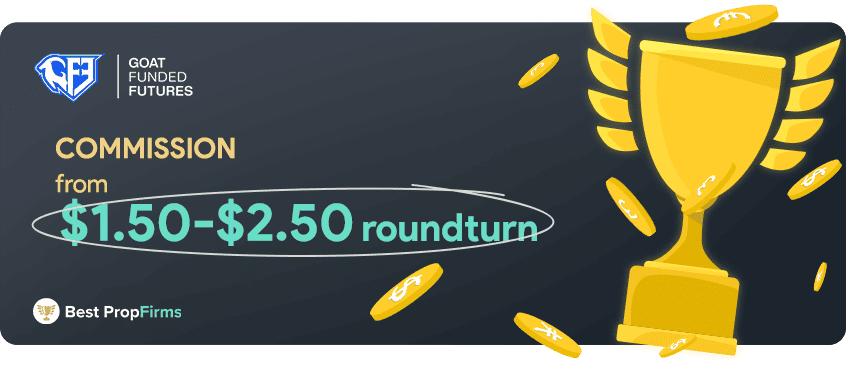
That said, while the pricing structure is transparent in format, the lack of hard number, especially for contract commissions, makes it harder to assess exact per-trade costs unless you’ve traded through similar feed setups before.
You don’t pay any extra for platform access, exchange connectivity, or real-time data. All pricing plans, including evaluation and funded accounts, come with live data feeds. GFF doesn’t specify whether this data is Level 1 or Level 2 CME depth, but for most discretionary futures traders, the included feed is sufficient for DOM scalping and order flow execution.
There’s also no charge for using third-party platforms like NinjaTrader, Quantower, ATAS, or Volumetrica. That makes GFF one of the few prop firms offering institutional-grade access without subscription or routing costs. However, it’s unclear whether exchange fees are absorbed by GFF or baked into per-contract commissions, an important detail if you trade frequently.
Commission is charged on a per-contract basis. While GFF does not list exact values publicly, most traders using Rithmic or Tradovate routing typically pay between $1.50 to $2.50 per round turn on major instruments like ES, NQ, and CL. Without formal disclosure, you should expect fees to fall within this range depending on your platform and account type.
Importantly, GFF does not differentiate pricing across asset classes. Whether you’re trading metals, indices, currencies, or soft commodities, the per-contract pricing model remains the same. That adds predictability, but the lack of exact commission rates still limits full cost transparency, especially for scalpers or high-frequency strategies where fees stack quickly.
Verdict on Futures Pricing
GFF scores 6/10 on pricing. You don’t pay for data, platforms, or account add-ons, and there are no hidden fees. That’s a major plus if you want low overhead from day one. But the lack of public commission rates and average spread data makes it difficult to calculate true cost-per-trade, especially for volume-based strategies
Goat Funded Futures gives you access to 55 tradable instruments across the CME Group’s most liquid futures markets. You can trade everything from equity indices to metals, energies, and major currency pairs.
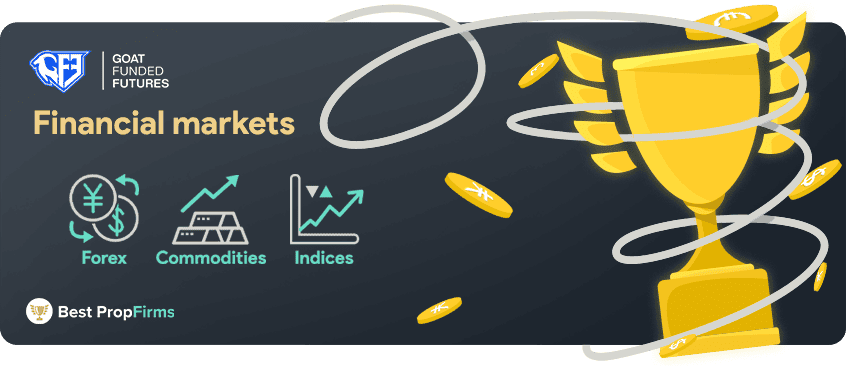
These are real exchange-traded products, not CFDs, which means tighter spreads, professional execution, and better alignment with institutional order flow.
The prop firm supports both full-size and micro contracts, and you’ll be assigned a max lot size based on your account tier. While GFF doesn’t disclose exact leverage ratios or margin levels, the firm applies variable margin aligned with standard CME practices. You get the same margin conditions during both the evaluation and funded stages.
You can trade the major US equity indices including the S&P 500 (ES), NASDAQ (NQ), and Dow Jones (YM), along with micro versions like MES, MNQ, and MYM.
These markets are highly liquid and ideal if you focus on intraday momentum or scalping strategies. Since you’re working with exchange-traded micros, you can manage risk in precise increments without breaching drawdowns too easily.
Gold (GC) and Silver (SI) are both supported, alongside Micro Gold (MGC) and Micro Silver (SIL). These contracts offer strong directional opportunities, especially during risk-off market phases.
While margins fluctuate with volatility, you can typically expect tighter sizing through micro contracts if you’re working with a smaller account.
If you’re comfortable with higher volatility, GFF lets you trade Crude Oil (CL), Micro Crude (MCL), and Natural Gas (NG). These are fast-moving markets and require strict discipline, particularly with trailing drawdowns in Instant accounts.
You won’t find static margin levels published, but the intraday risk is in line with most Rithmic-powered feed providers.
You also get access to major forex futures including EUR/USD (6E), GBP/USD (6B), and USD/JPY (6J), with micro versions available.
These are slower than indices but still give you meaningful movement during the US and London sessions. They’re also less margin-intensive, making them a good starting point if you’re new to futures.
If you want to diversify beyond the major assets, GFF includes futures like Corn (ZC), Soybeans (ZS), and Coffee (KC). These markets are more seasonal and less liquid, so you’ll need to manage exposure carefully.
They’re best used once you’ve scaled or if you have a specific directional bias backed by fundamental data.
Contract sizing is tiered by account. For example, a $30K account may be capped at 3 mini contracts or 30 micros, while a $75K account can handle 5 minis or 50 micros. Margin requirements are variable and platform-dependent, and you won’t see leverage percentages listed anywhere on the site.
If you’re used to CME margin specs, you’ll be able to navigate this. If not, this lack of clarity can make pre-trade risk planning more difficult.
Verdict on Markets and Leverage
GFF gives you full access to the most active CME futures markets, with the added flexibility of micro contracts for better risk control. You can trade equity indices, metals, energy, forex futures, and even agricultural contracts.
That said, the firm doesn’t disclose leverage or margin breakdowns, dropping their score to 6/10, which makes it harder to plan position sizing unless you already understand futures specs. If you’re an experienced trader, the offering is flexible and deep. If you’re new, you’ll need to do some extra homework.
Goat Funded Futures gives you access to a full suite of futures trading platforms with no extra fees for data or software. You can trade on GFF’s proprietary Project X or connect to several advanced third-party tools that are built specifically for order flow, volume analysis, and DOM-based execution.
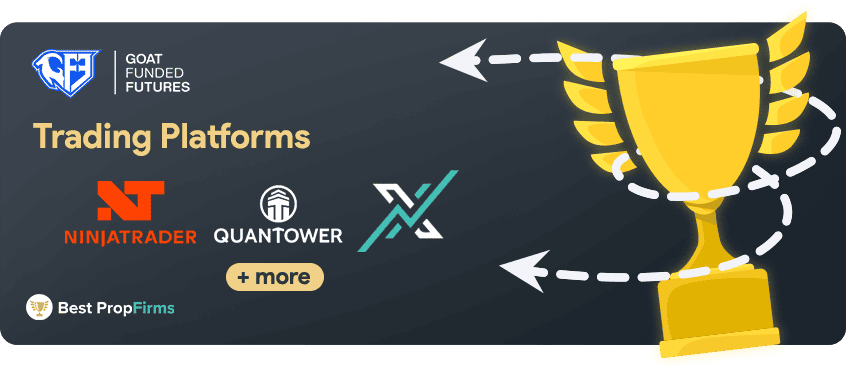
All futures platforms come with real-time market data, though GFF doesn’t confirm whether this includes Level 1 or Level 2 depth.
Project X is GFF’s in-house trading platform. It’s equipped with key features like bracket orders, order flow, and depth-of-market tools, giving you everything you need to manage risk and execution without relying on external software. If you prefer a plug-and-play setup, this is the most straightforward option.
You can also use well-known platforms including NinjaTrader, Quantower, Volumetrica, Volsys, ATAS, TradingView, VolBook, and Tradovate. These platforms are widely used by futures traders who rely on advanced analytics, footprint charts, and custom execution logic. Platform choice is flexible across all account types, and integrations are smooth.
No matter which platform you choose, you get access during both the evaluation and funded stages. Real-time data is included, and there are no additional charges for software or feed access.
You’re allowed to use copy trading between accounts you own, but you can’t mirror trades from other traders or signal services. GFF doesn’t state whether algorithmic trading or expert advisors are supported, so you’ll need to confirm this with support if automation is a key part of your strategy. There are no device-based limitations, but GFF does block access from certain restricted countries.
Verdict on Trading Platforms
GFF delivers a strong platform setup for serious futures trading scoring 8/10 in this area. You can use top-tier third-party tools or stick with their built-in Project X. The inclusion of real-time data and the lack of platform fees are major pluses. The only drawback is the lack of clarity around algorithmic trading support, which may matter if you use automated systems.
One of Goat Funded Futures’ biggest payout advantages is that you keep 100% of your first $10K in profit before any split applies. Once funded, you can start withdrawing as early as 10 days in, depending on your account type.
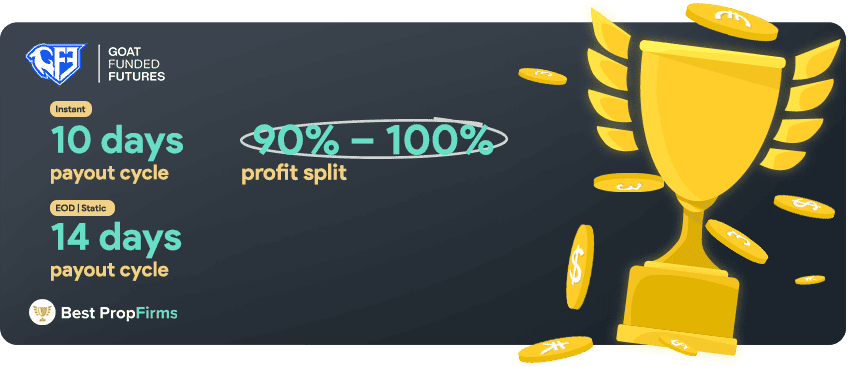
Fee payments are straightforward with no added charges for data or platforms, and the futures prop firm uses fixed payout windows to manage withdrawals through Riseworks.
You can pay for any challenge using crypto, credit card, PayPal, or Paytiko. GFF offers two billing models -the EOD and Static challenges are subscription-based, with monthly fees ranging from $99 to $349. The Instant Funding model charges a one-time fee between $349 and $699, depending on account size.
There are no additional costs for data feeds, software licenses, or platform access. Reset fees apply only to EOD ($99) and Static ($349) accounts. Instant Funding does not allow resets, so if you breach a rule, you’ll need to start over with a new plan.
KYC is only required when you’re ready to withdraw. For EOD and Static, that means after completing your evaluation. For Instant, you’ll complete verification before your first payout.
You keep 100% of your first $10K in profit, and after that its a 90% split. This increases as you scale, rising to 92% and eventually 95% at the GOAT Trader level.
Payout frequency depends on the model. EOD and Static accounts pay out every 14 days, while Instant accounts operate on a faster 10-day cycle. All plans require you to complete at least 6 trading days within the cycle to qualify. You can only submit a payout request during two fixed windows each month: the 5th to 8th or the 20th to 23rd.
The minimum withdrawal is $500 for EOD and Static accounts, and $250 for Instant. Maximum limits are tied to account size. A $30K account can withdraw up to $3,000 per cycle, while a $75K account allows up to $5,000. All approved withdrawals are processed via Riseworks within 2 to 3 business days.
Verdict on Payments and Payouts
GFF earns a 7/10 for payments and profit payments, with futures traders keeping the first $10K in full gives and the ability to get paid in as little as 10 days. Payment methods are broad, and Riseworks helps ensure reliability. That said, fixed withdrawal windows and the inability to reset Instant accounts limit how fast you can recover or scale if things go off track.
Goat Funded Futures offers 24/7 support through multiple channels, but the quality of help can be inconsistent. While live chat and email are available, response times are slow, and answers often lack detail. Educational content is also minimal, which may leave you needing to rely on outside resources or prior futures trading experience.
You can reach GFF through email, live chat, or their Discord server. Support is technically available 24/7, but many traders report long wait times and vague responses. Trustpilot reviews consistently mention delays and unhelpful answers, especially around rule clarifications, payout logistics, and platform issues.
While the Discord community exists, support staff are not reliably active or responsive there. If you’re looking for fast, hands-on help, you may find the experience frustrating. Most issues eventually get resolved, but you’ll need to be patient and often persistent.
Educational content at GFF is limited. Aside from a basic FAQ page on their website, there are no tutorials, webinars, or platform walkthroughs provided directly by the firm. If you’re new to futures or need help navigating platforms like NinjaTrader or Quantower, you’ll need to seek training elsewhere.
There’s no structured guidance on challenge strategy, rule interpretation, or performance tracking. This creates a steeper learning curve, especially for traders coming from CFD or forex-funded programs who may not be familiar with CME contract specs or intraday margin mechanics.
Verdict on Customer Support and Education
GFF’s customer support options are in place, but the lack of clear, timely answers hurts the user experience. Education is bare-bones, which means you’ll need to come in with experience or be prepared to do your own research. If you’re confident navigating futures platforms on your own, this may not be a dealbreaker. But for beginners, it’s a weak spot.
Goat Funded Futures is not a broker backed prop firm. Reviews are split, with some traders praising the low-cost entry and futures access, but others raising valid concerns about support quality and Discord moderation.
Goat Funded Futures holds a 3.7 out of 5 Trustpilot rating from 54 reviews. Positive feedback highlights the simplicity of the evaluation models, quick setup process, and strong trading conditions. Many users liked the lack of activation fees and user-friendly dashboard.

However, negative reviews make up nearly 30% of the total. Common complaints include delays receiving funded account credentials after passing, poor follow-up from support, and repeated “escalation” messages with no resolution. Several reviewers said they waited over two weeks with no account access. The firm has not publicly responded to most of these complaints.
GFF operates an active Discord and appears present on social media, but community trust is mixed. While the server is marketed as a live support and engagement channel, multiple users report being muted or banned after questioning delays or sharing concerns. In some cases, entire threads were deleted.
Community transparency is limited — payouts are not regularly showcased, and verified success stories are rare. Traders who rely on Discord for peer feedback may find the environment restrictive.
Verdict on Trust and Community
Goat Funded Futures scores 5/10 because while the prop firm has a visible founder and strong platform offering, it lacks consistent transparency and has unresolved customer experience issues. If you value open community dialogue and fast responses, this could be a drawback.
Getting started with Goat Funded Futures is straightforward. You can register and begin trading in just a few steps:
Goat Funded Futures scored 65/100 in our testing. The biggest advantage is the ability to keep 100% of your first $10K in profit, paired with access to raw spreads, advanced futures platforms, and Instant Funding for those who want to skip evaluations. You can choose between flexible subscription models or a one-time fee, and funded accounts benefit from a well-structured scaling plan. Payouts are fast, transparent, and handled via Riseworks.
That said, the firm still has key weaknesses. There’s no reset option for Instant accounts, education is limited, and support responses are often slow or vague. GFF also lacks transparency on fees like commissions and leverage, which could make planning harder if you’re not familiar with futures. If you already understand CME trading and want fast access to funding, GFF is worth a look. For beginners or traders who value active support, other options may offer a smoother experience.

Noam Korbl is the co-founder and has been a trader since 2014. He has Finance degree at Monash University and is an investor in shares and equities and successfully started and sold the online business Hearing Choices.
Copyright 2025 Prop Firms. All rights reserved.
Ask an Expert